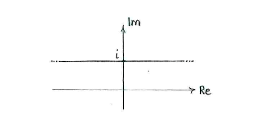Lösung 3.2:2e
Aus Online Mathematik Brückenkurs 2
(Unterschied zwischen Versionen)
| Zeile 1: | Zeile 1: | ||
| - | + | Wir schreiben die gesuchte komplexe Zahl <math> z </math> mit ihrem Realteil und Imaginärteil. Nach Aufgabenstellung ist der Realteil <math> x </math>, den unbekannten Imaginärteil nennen wir <math> y </math>. | |
| - | + | {{Abgesetzte Formel||<math>z = x + i y </math>.}} | |
| - | + | ||
| - | + | Es soll also gelten | |
| - | {{Abgesetzte Formel||<math>x=x+(1-y)i | + | {{Abgesetzte Formel||<math> x = i + \overline{z} = i + (x -iy) = x + i (1-y) </math>.}} |
| + | |||
| + | Also soll gelten | ||
| + | {{Abgesetzte Formel||<math> x = x + i (1-y) </math>}} | ||
| + | und das ist äquivalent zu | ||
| + | {{Abgesetzte Formel||<math> 0 = i (1-y) </math>.}} | ||
daher ist <math>y=1</math>. | daher ist <math>y=1</math>. | ||
| - | Also besteht unsere | + | Also besteht unsere Lösungsmege aus allen komlexen Zahlen deren Imaginärteil 1 ist. |
[[Image:3_2_2_e.gif|center]] | [[Image:3_2_2_e.gif|center]] | ||
Version vom 17:10, 14. Sep. 2009
Wir schreiben die gesuchte komplexe Zahl \displaystyle z mit ihrem Realteil und Imaginärteil. Nach Aufgabenstellung ist der Realteil \displaystyle x , den unbekannten Imaginärteil nennen wir \displaystyle y .
| \displaystyle z = x + i y . |
Es soll also gelten
| \displaystyle x = i + \overline{z} = i + (x -iy) = x + i (1-y) . |
Also soll gelten
| \displaystyle x = x + i (1-y) |
und das ist äquivalent zu
| \displaystyle 0 = i (1-y) . |
daher ist \displaystyle y=1.
Also besteht unsere Lösungsmege aus allen komlexen Zahlen deren Imaginärteil 1 ist.

